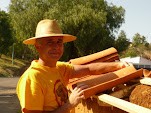Empecé a aplicar el cob (simplemente una mezcla de tepetate (arena y barro) molido con paja) a la que adicióne una solución de 10% de silicato de sodio. El silicato de sodio me lo recomendó Mauricio, para mayor resistencia a la tierra. Para comprobarlo, haré la barda con tres diferentes mezclas:
- una parte será tepetate con silicato
- otra parte será tepetate con paja
- la última parte será de tepetate con silicato y con barro
Veré cuál de ellas da mejor resultado.
After a month of not beng able to work on the construction, I finally continued with the wall. I started "cobbing" (cob: mixture of sand, clay and straw, similar to adobe but you apply it directly on the wall instead of making bricks first). I added a solution with 10% of sodium silicate. Mauricio recommended to add the silicate for a bigger strength. To put it on test, I´ll make three different mxtures:
- soil with silicate
- soil with straw
- soil with straw and clay
.JPG)
Aquí se ve la fresa de tierra (rototiller) que estoy usando para pulverizar el tepetate:
Here the rototiller I am using to grind the soil:
.JPG) Y estos son los muy modestos avances del día de hoy.
Y estos son los muy modestos avances del día de hoy.And this is the small progress of today.
.JPG)
.JPG)
Me enfrenté a un dilema: si hago la mezcla muy líquida, es fácilmente moldeable pero también fluye en exceso cuando se coloca sobre la barda, por lo que puedo poner solamente una delgada capa a la vez. Además, se agrieta fácilmente. Por el contrario, si hago la mezcla con muy poca agua, entonces es muy poco maleable y difícil de conformar. Aun debo ganar más experiencia para encontrar el punto óptimo.
Por cierto, me visitó Marta de improviso. ¡gran alegría!
I faced a dilemma: making a wet mixture, the application is very easy but it also deforms a lot with weight. I can raise the wall only a couple of inches at a time. And it cracks easily.
On the contrary, if the mix has less waterm then it is not easliy workable and hard to mold. I still have to gain experience to find the "sweet spot".
By the way, Marta came to vist. Big hapiness!!

.JPG)
.JPG)

.JPG)
.JPG)


.JPG)
.JPG)
.JPG)






.JPG)
.JPG)
.JPG)
.JPG)
.JPG)
.JPG)
.JPG)
.JPG)
.JPG)
.JPG)

.JPG)
.JPG)

.JPG)
.JPG)
.JPG)
.JPG)

.JPG)
.JPG)


.JPG)




.JPG) Y DESPUÉS....
Y DESPUÉS.....JPG)
